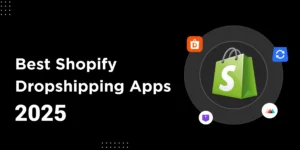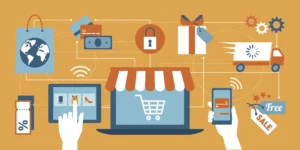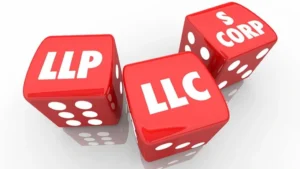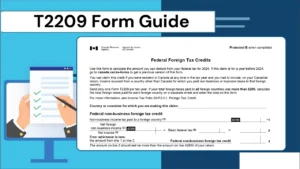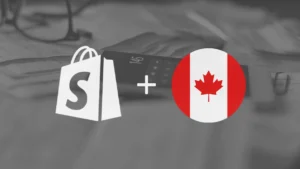You want to master Shopify dropshipping. This guide shows you how to dropship on Shopify – step by step, from setup to profits, with no inventory. The surprise here is that the dropshipping market reached $435 billion in 2025, up 23% in one year. Yet 90% of beginners still fail.
We at SAL Accounting will fix it. In this post, you will learn the best dropshipping suppliers for Shopify, top apps, and easy bookkeeping hacks to join the top 10%. Let’s launch your store.
Quick Takeaways
- Shopify dropshipping lets you sell products without holding inventory, making it an easy way to start an online store.
- Keep your startup costs low with a $29/month Shopify plan and no need to buy stock upfront.
- Choose a niche, use trusted apps like DSers or Spocket, and automate product imports and order fulfillment.
- Monitor your profit margins closely and aim for 30%+ after ads, shipping, and fees.
- Set up taxes, use accounting apps, and keep track of expenses to stay organized and avoid costly mistakes.
What is Shopify Dropshipping?
Shopify dropshipping lets you sell stuff online without stocking anything yourself. A customer orders from your store, you grab the item from a supplier, and they ship it straight to the buyer (source). You save cash and hassle, no storage, no packing, no shipping headaches. Shopify handles the store setup and supplier links, so you just focus on making sales. And you keep your finances clear with our trusted Shopify tax accountant in Toronto today.
Why Shopify Dropshipping Is Great for Beginners
Shopify dropshipping delivers clear advantages for new entrepreneurs. You start with low costs, avoid inventory, and scale without hassle.
- Low Startup Costs: You skip buying stock or storage. Shopify starts at $29/month (pricing plan).
- No Inventory Management: Suppliers keep the stock and ship orders. You handle sales and marketing. Handling Shopify inventory management is not easy.
- Flexibility: Run your store from anywhere with the internet.
- Easy to Scale: Add new products fast. No big money needed.
- Wide Product Selection: Sell tons of items without holding any.
Example: Imagine you want to sell Wireless Earbuds. No need to spend thousands on stock. Pay $29/month for Shopify Basic. List earbuds from suppliers right away. Zero inventory cost.
Shopify Dropshipping Step by Step: Your 8-Step Launch Plan
Follow this Shopify dropshipping step-by-step plan, and your store will go live in days. Check out the guide on Shopify sales and income tax in the US and Canada for more.

Step 1: Sign Up and Name Your Store
Head to shopify.com. Click “Start free trial” for 3 days free. Choose the $29/month Basic plan after. No card needed yet. Pick a short, memorable name like “EcoKitchenHub.” Check domain availability. Grab a custom one for $15/year inside Shopify. It builds trust fast.
Step 2: Pick a Niche and a Theme
Focus on a niche like pet accessories or eco gadgets. Search TikTok or Google Trends for hot items. Skip crowded areas. In Themes, install free Dawn. It’s fast and mobile-friendly. Change colors to fit your brand. Add a simple Canva logo.
Step 3: Install the Dropshipping App
Open the Shopify App Store. Add DSers (free tier) or Spocket ($24/month). Installation takes seconds. DSers link to AliExpress. Spocket offers US/EU suppliers for 3–5 day shipping. This automates product imports and orders. Learn more about how to automate your Shopify store step by step.
Pro Tip: Start with a DSers free plan. Upgrade only after 50+ orders.
Example: Imagine you install DSers in your Shopify store. Link it to AliExpress. Import Pet Grooming Kits with a few clicks. Products sync automatically. Ready to sell instantly.
Step 4: Find and Import Products
Browse app catalogs. Choose $20–$50 retail items that cost $5–$15 from suppliers. Target 30%+ profit. Press “Import” and products appear in your store. Use the best accounting practices and tips for Shopify to get the desired results. Rewrite titles for benefits, like “Leakproof Travel Dog Bowl.” Use pro images. Price 2–3x cost.
Step 5: Connect Suppliers
In DSers, connect to the AliExpress account. For Spocket, pick US warehouses. Import one test item. Place a fake order. Confirm the app pushes it to the supplier. Fix issues now.
Step 6: Set Payments and Shipping
Go to Settings > Payments. Activate Shopify Payments for cards. Add PayPal. Set shipping zones. Charge $5–$10 flat or free over $50. Suppliers pay actual delivery, and you keep the difference.
Pro Tip: Offer free shipping over $50. It boosts average order value by 30%. See how to match transactions, payouts, and fees in Shopify payment reconciliation.
Step 7: Add Legal Pages
Use Shopify’s built-in generator. Create Privacy Policy, Refund Policy, Terms of Service. Insert your store name. Publish them in the footer. Customers feel safe. You stay protected.
Step 8: Test and Launch
Remove the password in Preferences. Buy one item yourself (refund it). Track from order to delivery. Everything is smooth. Share your link. You’re open for business.
Pro Tip: Sell one product for 7 days. Gather feedback before adding 20 more. Do not forget that you can always ask help of our E-commerce accountants and professionals for free consultation.
How to Choose the Best Products for Shopify Dropshipping
The right products can make or break your dropshipping business. Here’s how to pick the best ones:
- Stick to One Niche: Sell only pet toys or kitchen gadgets. It helps you stand out and reach the right buyers.
- Check Demand: Use Google Trends or Amazon Best Sellers. Amazon and Shopify integration may also be helpful. Find items people search for now.
- Avoid Heavy Competition: Demand matters, but skip oversaturated items. Less competition means easier sales.
- Pick Quality Items: Choose suppliers with solid products. This cuts complaints and returns.
- Aim for Good Margins: Buy low, sell higher. Cover ads and fees. Keep 30%+ profit.
Example: Imagine you sell Bluetooth Speakers. Pick a supplier with 4.5+ stars and great reviews. Customers receive top-quality items. Returns and complaints stay low.
Which Are the Best Dropshipping Suppliers for Shopify in 2025?
You need the best dropshipping suppliers for Shopify that sync fast and ship reliably. Shopify GST/HST for Canadian sellers is also important. These top picks work directly inside Shopify. They cut delays and boost profits.
| Supplier | Shipping (US) | Pricing | Best For | Rating |
| Spocket | 3–5 days | Free–$99/mo | Fast US/EU delivery | 4.9 |
| CJdropshipping | 3–6 days | Free | Huge variety & sourcing | 4.9 |
| Zendrop | 8–10 days | Free–$49/mo | Branding & automation | 4.7 |
| Printful | 8–14 days | Free–$25/mo | Custom print-on-demand | 4.6 |
| Modalyst | 5–8 days | Free–$35/mo | Fashion & premium items | 4.2 |
- Spocket: US and EU warehouses deliver in 3–5 days. Customers get orders fast. Returns drop. Repeat buyers love it.
- CJdropshipping: Access over 1,000,000 products. The free sourcing team finds items. Custom packaging available. Covers every niche.
- Zendrop: Zendrop auto-syncs every order instantly. Add your logo to packages and thank-you cards. Builds brand loyalty fast. See how to automate your Shopify store with A2X.
- Printful: Design custom t-shirts, hoodies, mugs, posters. No upfront stock. Ships worldwide with your branding.
- Modalyst: Curated high-end fashion and luxury brands. Premium suppliers. Low starter fees. Modalyst is perfect for clothing niches.
Pro Tip: Run 5 test orders through 2 suppliers. Compare speed, tracking, and packaging. Scale with the best one.
What Are the Must-Have Shopify Dropshipping Apps?
Shopify dropshipping apps handle the heavy lifting for your store. They import products, process orders, collect reviews, send marketing emails, and manage accounting. The top accounting software for Shopify sellers helps a lot. Install these five to run smoothly:
1. DSers
Free to start. It connects directly to AliExpress and lets you import thousands of products with one click (DSers on Shopify store). Every time a customer orders, DSers sends it to the supplier automatically and updates tracking in your store.
2. Spocket
$24/month. This app links to US and EU warehouses for 3–5 day shipping. You can import items fast and send branded invoices. Customers get orders quickly, which cuts complaints. This is among the best e-commerce accounting software in 2025.
3. Loox
$9.99/month. After delivery, Loox emails buyers and asks for photo reviews with a discount code. It displays real customer photos on your product pages to build trust and boost sales.
4. Klaviyo
Free for the first 250 contacts. Klaviyo creates email and SMS campaigns (sign up). It recovers abandoned carts, sends welcome series, and promotes repeat purchases. You see exactly how much revenue each email brings.
5. A2X
$19/month. A2X pulls all Shopify sales into QuickBooks or Xero. It matches payouts, splits fees and refunds, and creates clean Shopify dropshipping accounting reports in minutes. Check how to sync, automate, and reconcile your store with Shopify Integration with QuickBooks.
Pro Tip: Install Loox and Klaviyo on launch day. Reviews and emails drive 30% of repeat sales.
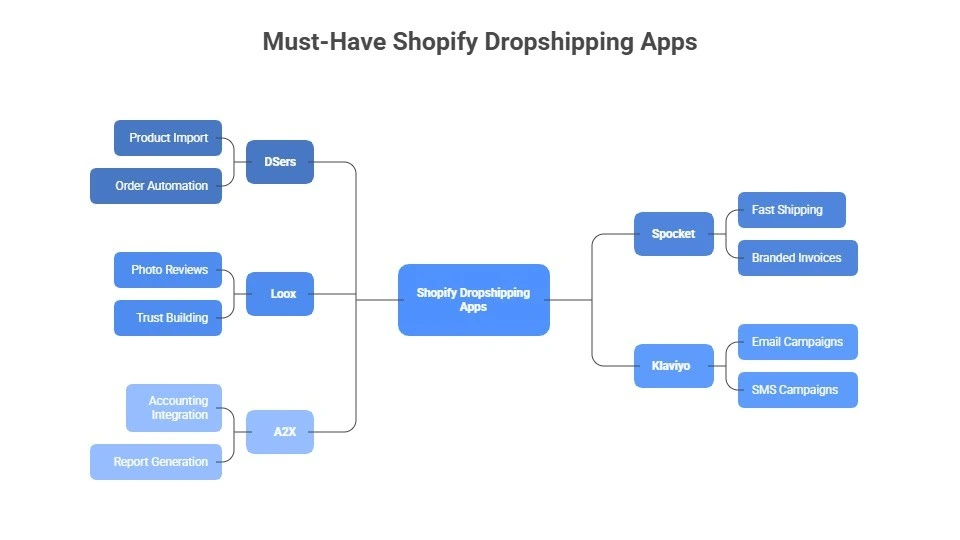
How Does Inventory Management & Automation Work in Dropshipping with Shopify?
Dropshipping with Shopify keeps you from holding any stock. Suppliers manage that part. You just sell and let apps handle the rest:
- Inventory management tracks product levels in real time: Apps like DSers or Spocket connect to suppliers. They sync stock updates every few minutes. If a supplier runs low on an item, your store hides it automatically. This stops overselling and unhappy customers.
- Automation takes over orders: A customer places a buy. The app instantly forwards details to the supplier. They pack and ship. Tracking info pops back into your Shopify dashboard. You notify the buyer with one click. Check out the best Shopify integrations for e-commerce to do the process smoothly.
- AI makes it smarter: Tools like AutoDS predict demand and adjust prices. They even suggest new products based on trends.
Pro Tip: Set alerts for stock under 10 units. Switch suppliers quickly to avoid gaps.
How to Handle Taxes for Shopify Dropshipping
Taxes stay simple if you set them up right. Shopify dropshippers follow these rules:
Sales Tax
You collect tax based on where the customer lives. Shopify calculates it automatically. It uses your store location and the buyer’s address. Turn on tax settings in Shopify. It adds the right amount at checkout. Dropshipping taxes in the US are clear, and you must know them.
Income Tax
Your dropshipping profits count as taxable income. Track every sale and expense. Use A2X or QuickBooks to pull data from Shopify. They create clean reports for tax time.
- Track earnings and costs every week.
- Run monthly profit reports with apps.
- Check tax law updates yearly.
- International Taxes
If you sell to other countries, you may need to charge VAT or GST. Each country has rules. Research before shipping there. Use Shopify’s tax tools to add rates. Check out dropshipping taxes in Canada to stay compliant.
Pro Tip: Enable automatic tax collection on day one. It prevents costly mistakes later.
How to Handle Shopify Dropshipping Accounting & Bookkeeping
Good accounting keeps your Shopify dropshipping business on track. Follow these steps:
- Track Earnings and Expenses: Record every sale and cost. Use QuickBooks or A2X. They pull data from Shopify automatically.
- Separate Business and Personal Finances: Open a dedicated business bank account. Keep personal money out. This makes reports clean.
- Monitor Profit Margins: Check margins weekly. Subtract ads, shipping, and fees. Aim for 30%+ net profit.
- Use Shopify Reports: Shopify shows sales, refunds, and payouts. View them in the dashboard. Export for deeper analysis. The month-end close process & checklist for Shopify stores is necessary.
- Prepare for Tax Season: Save receipts and run monthly reports with A2X. Hand them to your accountant.
Grow confidently with accurate records using our Shopify accounting and bookkeeping services. The table below shows the key steps for managing your Shopify dropshipping accounting and bookkeeping:
| Task | Action | Tools | Frequency | Purpose |
| Track Earnings and Expenses | Record sales and costs. | QuickBooks, A2X | Weekly | Accurate tracking |
| Separate Finances | Open a business account. | N/A | One-time | Keep finances clean |
| Monitor Profit Margins | Check margins, aim for 30%+ profit. | Shopify | Weekly | Ensure profitability |
| Use Shopify Reports | Review sales, refunds, payouts. | Shopify Dashboard | Monthly | Analyze performance |
| Prepare for Tax Season | Save receipts, run reports. | A2X | Monthly | Tax preparation |
Case Study: Fix Accounting Chaos for Toronto Dropshipper1
A Toronto Shopify store contacts SAL Accounting:
Problem: The store earns $15,000 monthly from eco-friendly kitchenware. Manual spreadsheets tangle Shopify payouts, supplier costs, and ad fees. A $1,800 refund error sparks a CRA notice in March 2025. Tax prep takes 25 hours.
What We Do: We set up A2X for $19/month. It syncs Shopify sales to QuickBooks daily. We schedule weekly payout checks to match bank deposits. We separate fees, refunds, and ad costs. Per-product profit reports run instantly.
The Result: The store catches errors in 10 minutes weekly. They avoid $4,200 in tax penalties. Monthly P&L reports finish in 5 minutes. They scale to $50k/month by July 2025, no accountant needed.
How to Market & Scale Your Shopify Dropshipping Store
Marketing brings buyers, and scaling grows your dropshipping business. Use these channels and steps to achieve your targets:
1. TikTok Shop & Organic Videos
Post 3–5 product videos daily. Use trending sounds. Add #TikTokMadeMeBuyIt. Link directly to Shopify. One viral clip drives 100+ sales.
2. Facebook & Instagram Ads
Start with a $10/day budget. Target lookalike audiences of past buyers. Retarget cart abandoners. Aim for 3x return on ad spend. Also, learn more about WooCommerce setup taxes in Canada.
- Test 3 creatives per ad set.
- Kill losers after $20.
- Scale winners to $50/day.
3. Email + SMS with Klaviyo
Send welcome series, abandoned cart emails, and post-purchase upsells. Recover 10–15% of lost sales. Track revenue per message.
4. SEO Blog Content
Write 10 posts like “Best Pet Toys 2025”. Optimize for Google. Free traffic builds over time. Link to products.
- Use AnswerThePublic for questions.
- Add internal links to products.
- Update posts yearly.
5. Influencer Marketing
Pay micro-influencers $50–$200 for unboxing videos. One good post brings 50–200 sales fast.
Example: Run a $10/day Instagram ad for your “Pet Accessories” store. Target pet owners with a new “Pet Bed.” After 3 days, sales roll in. Scale to $50/day. Boost visibility and profits with zero inventory risk.
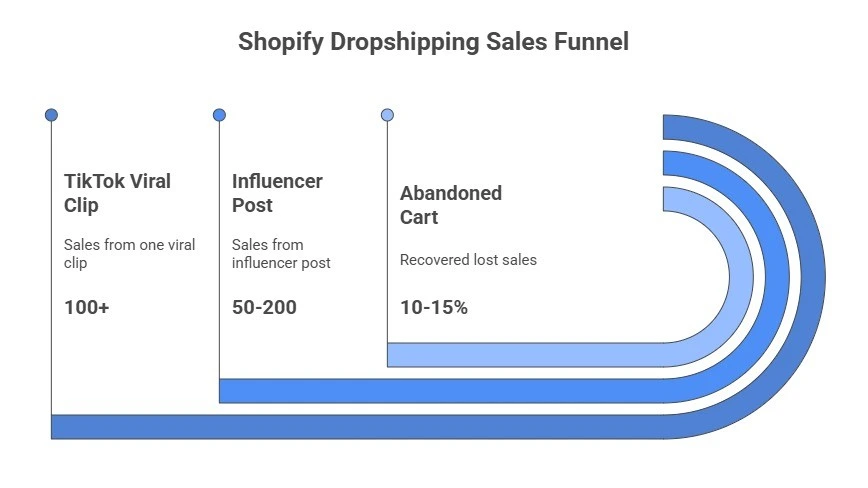
What Common Mistakes Should You Avoid in Shopify Dropshipping?
Beginners repeat the same errors in how to dropship on Shopify. Mistakes that e-commerce sellers make are sometimes costly. Skip these to join the top 10%.
- Slow Suppliers & Bad Product Photos: AliExpress takes 30 days, and low-res images look cheap. Customers cancel. Use Spocket for 3–7 day delivery. Swap for lifestyle shots. Edit in Canva or pay $5 on Fiverr. Test 3 orders first.
- No Automation: Manual orders waste hours. DSers or Zendrop syncs everything. Set up in Step 3. Save 10 hours weekly.
- Ignored Taxes & Legal: No tax setup risks audits. Turn on Shopify taxes day one. Add Privacy Policy. Avoid $1,000 fines.
- Zero Marketing Budget: Stores need ads. Spend $10/day on TikTok or FB from launch. Land first sale in 48 hours.
- Poor Customer Service: Slow replies mean refunds. Use Shopify chat. Answer in under 2 hours. Keep buyers happy.
Pro Tip: Track returns weekly. High rates signal bad suppliers. Open Shopify > Analytics > Returns every Monday. Flag items over 5%. Test new suppliers. Move the listings to the best one. Stay organized and profitable with expert bookkeeping for e-commerce at SAL Accounting.
Case Study: Turn Calgary Store Around from Common Mistakes2
A Calgary Shopify store contacts SAL Accounting:
Problem: Their pet toy niche struggles with 25-day AliExpress shipping. Blurry photos trigger 18% returns. Manual order entry eats 20 hours weekly. $3,000 in Facebook ads yields just $800 profit in April 2025.
What We Do: We switch to Spocket for 4-day US shipping. We enhance photos with Canva for vibrant appeal. We install DSers to automate order fulfillment. We move $50/day to TikTok ads, testing three creatives.
The Result: Returns fall to 2%. They save 15 hours weekly. TikTok ads deliver 4x ROAS. Profit hits $6,000 monthly by June 2025. The store runs smoothly and scales fast.
Final Thoughts
Shopify dropshipping puts a profitable store in your hands with zero inventory. Follow this step-by-step guide: launch in 8 steps, pick the best dropshipping suppliers for Shopify, automate with top apps, and master accounting and taxes. This path keeps your business lean, compliant, and ready to scale.
For help with Shopify dropshipping accounting, tax setup, or growth strategy, contact us at SAL Accounting. Our team makes numbers simple and profits real.
Shopify Dropshipping FAQs
Yes. The market reaches $435 billion, up 23%. Margins hit 20-30% with smart niches and suppliers. 10% succeed with proven steps.
Shopify Basic costs $29. Add free DSers or $24 Spocket. Starter total: $50-100.
No at start for US/Canada. Register after $30k sales or per local rules.
Shopify auto-collects sales tax. Track income with A2X. Remit GST/HST over $30k in Canada; nexus-based in the US. File quarterly.
Spocket (4.9 rating) for fast US/EU shipping. DSers for AliExpress volume (free).
Yes. A2X syncs to QuickBooks or Xero for clean reports.
TikTok for organic videos. FB/IG Ads for targeting. Email/SMS (Klaviyo) for retention.

